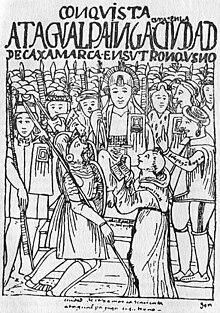User:Amelia-the-comic-geek/sandbox
History of Martial arts in the Americas[edit]
North America[edit]
- Jailhouse rock (fighting style)
- Rough and tumble fighting
- SCA armoured combat
- Gun fighting
- Combatives
South America[edit]

Martial arts in South America have a long, vibrant but poorly attested history due to the indigenous population never developing true writing and the secrecy in which many post-colonial martial techniques were both conceived and practiced in. The earliest known depiction of combat between individuals on the continent dates back to approximately 7000 BCE on rock art in -place- in Brazil and may be the basis of the pax-xinguan martial art and game known as huka-huka. Many martial arts developed after the colonization period were developed as means of self-defense among captured slaves and many of which have their origins in stick fighting found throughout West Africa.
Martial traditions were no stranger in the Inca Empire. Warachikuy was a ceremony in which the sons of nobles competed in various physically demanding activities of skill, bravery and constitution, which included simulated combat.[1] Fray Bartolomé de las Casas, a Spanish encomendero recounted observations regarding martial arts practice and military training within the empire in the fifth chapter of the volume Historiadores de Indias. Within the text, he claims that children and young men typically from 10 to 18 years old would battle in mock or even real combat and train with weaponry. The strongest and most capable of these boys would become soldiers.[2]
Peruvian martial artist Juan Ramón Rodríguez Flores came to national attention in the early 1970s for his writings of a martial art known as Rumi Maki, translating to 'Hand of Stone' or 'Stone Fist' in the Quechua language, which he claimed to be a fighting style developed within the Inca Empire.[3]
American anthropologist Napoleon Chagnon described instances of violent conflict between the Yanomami in his controversial[4] book, Yanomami: The Fierce People, including formal, rule-based fights he dubbed "chest pounding duels". In these duels, two fighters from two teams would stand arm-length across each other and take turns striking the other in the chest until one side was too injured to continue. If the loser were to retire from the fight, another individual from his team would replace him and strike at the winner until the winner likewise was too injured to continue. Though these fights were not typically to the death, he noted sometimes weapons were involved.
According to legend, the wrestling game huka-huka was first performed at Saginhenhu, a place later confirmed to be Cachoeira do Adelino, near the municipality of Iconha.[5]
wow this project turned out to be a lot bigger then I expected. Still need to cover machete fighting, Haitian martial arts, Capoeira, BJJ, and soooo much North America stuff
References[edit]
- ^ Cárdenas Fernández, L (2018). The Incan Army: Volume II Strategy, Tactics and Logistics. Translated by Graham, Eliza. Babelcube Incorporated. ISBN 9781547551910.
- ^ Casas, Bartolomé de las (1559). Historiadores de Indias (in Spanish). p. 176.
- ^ Flores, Juan Ramon; Vega, Alex (2007). Rumi Maki Fighting Arts. Blue Snake Books. ISBN 9781583941805.
- ^ Borofsky, R. (2005). Yanomami: The fierce controversy and what we can learn from it (Vol. 12). Univ of California Press.
- ^ Zawadzki, C. H., Birindelli, J. L. O., & Lima, F. C. T.. new armored catfish species of the genus Hypostomus Lacépède, 1803 (Siluriformes: Loricariidae) from the upper rio Xingu basin, Brazil. Neotropical Ichthyology (Report). p. 245–253.
{{cite report}}: CS1 maint: multiple names: authors list (link)

